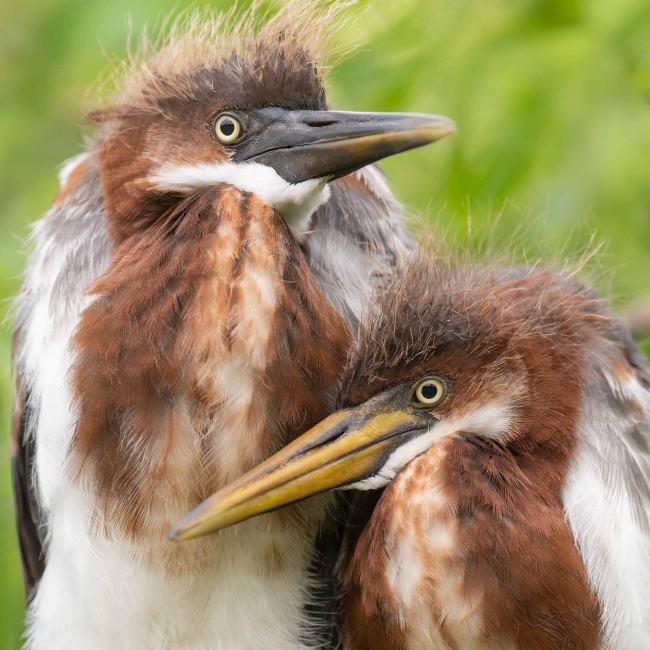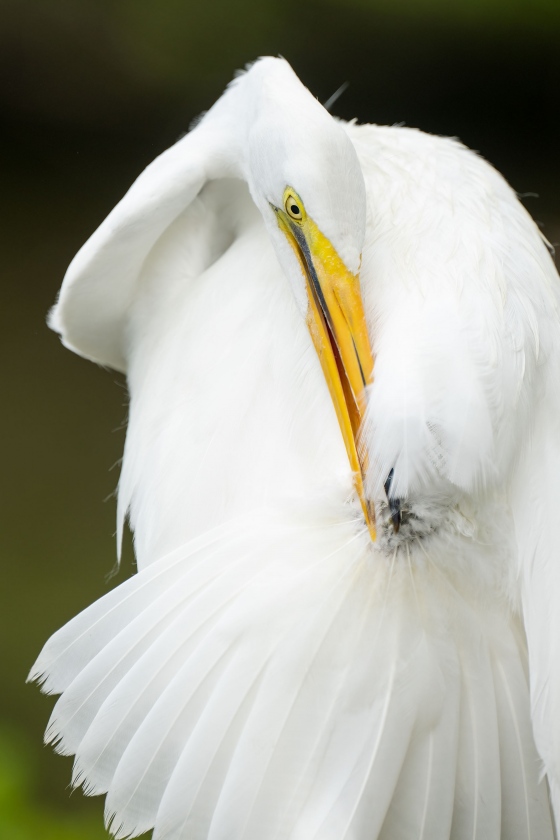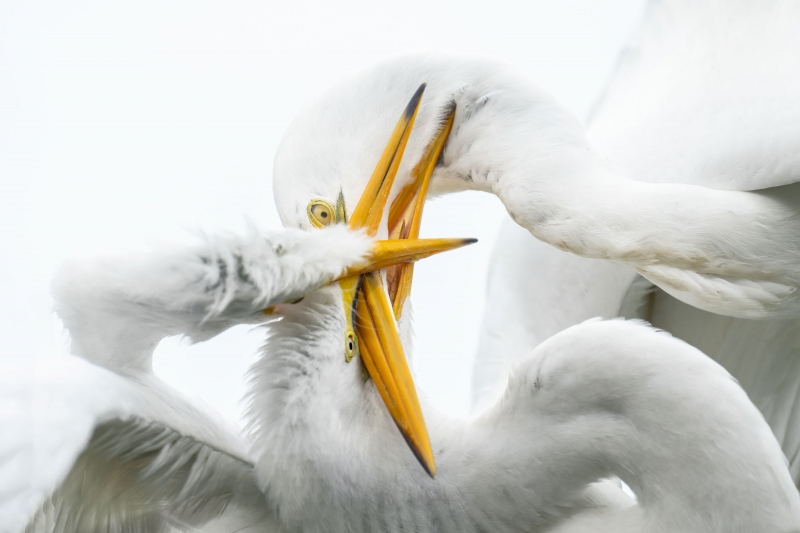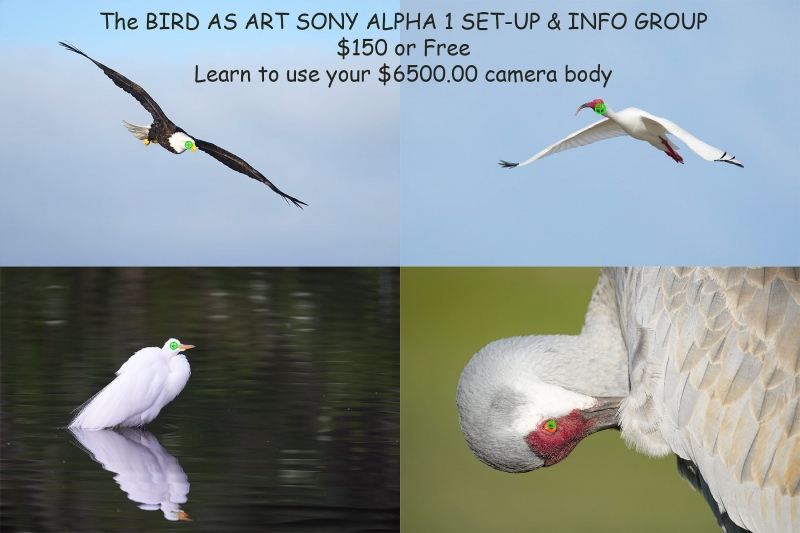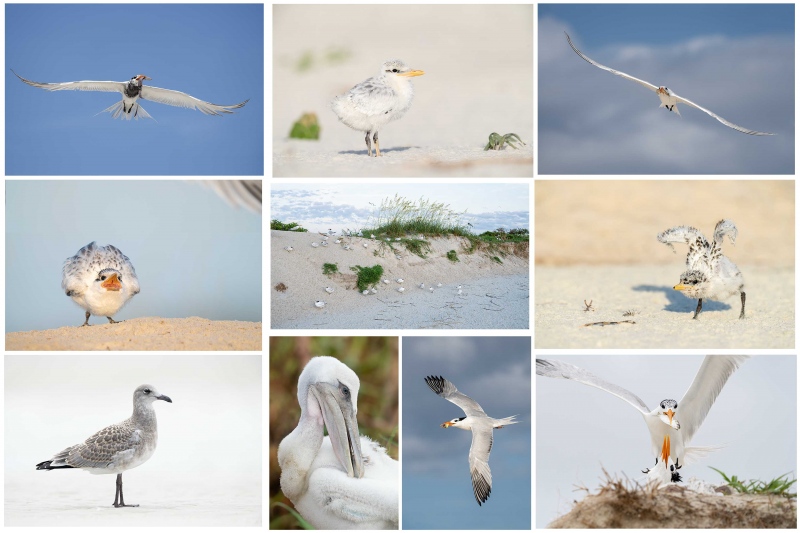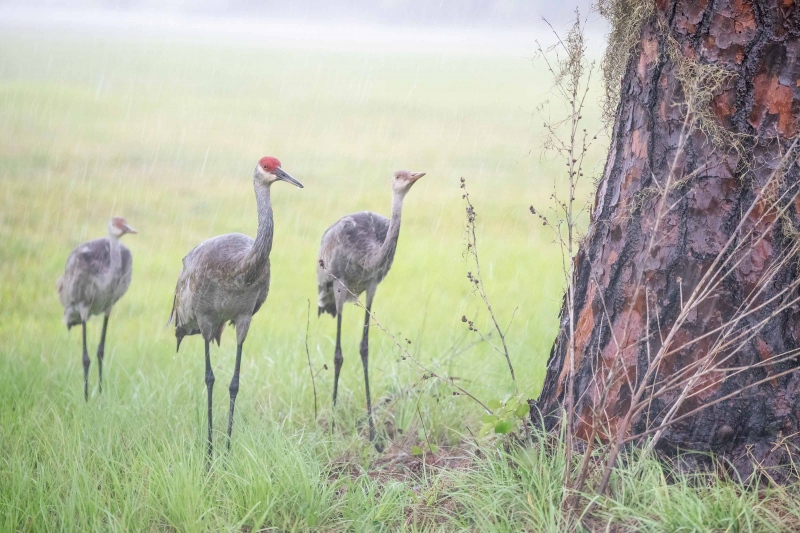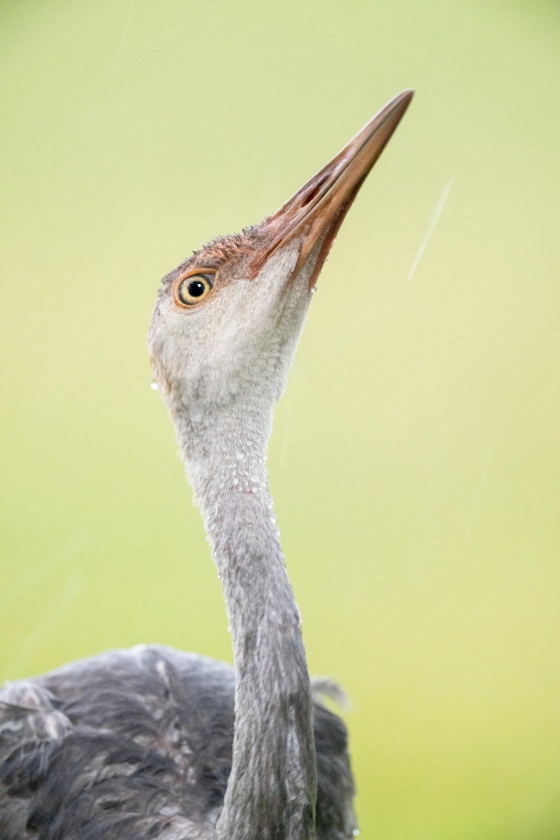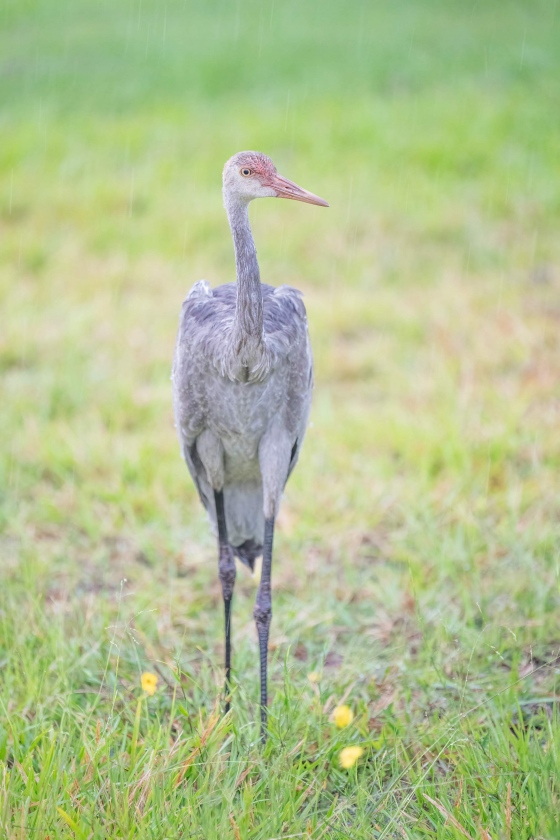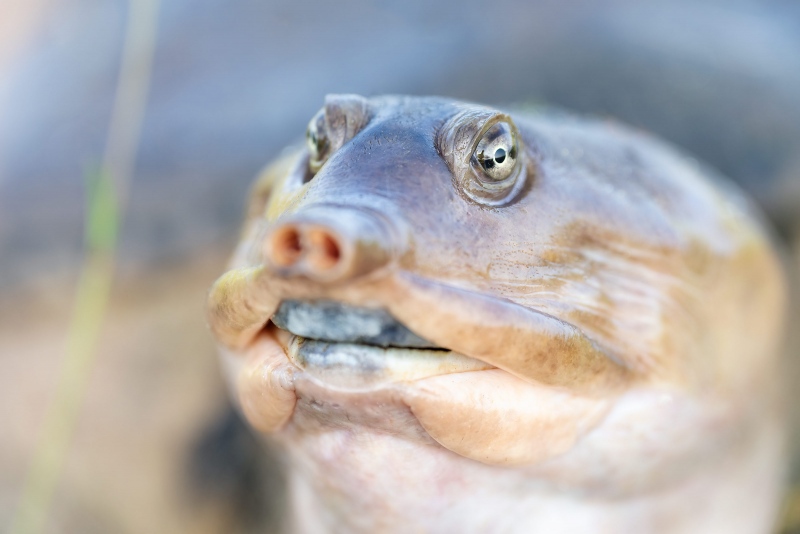Which of Today’s Three Featured Images is Your Favorite?
Why?
What’s Up?
It all began with a great night of sleep on Friday. I was to be very early and woke to the alarm at 4:30am to pack the car and make my tea for the road. I met Vince Delack at Gatorland at 6:50am. He was personable and eager to learn. He worked mostly with the handheld Canon 100-400 II and an R5. At my urging, he is in the process of retiring his 7D Mark II. He was a quick study. I showed him how to evaluate the histogram after making a test exposure. He quickly began making perfect exposures. We worked on AF stuff, and he quickly had that down pat. He shot on his own for a while and when I reviewed his images, there were lots of mis-framed photos and terribly busy backgrounds. I urged him to work at the long end to reduce clutter. I explained to him that folks who are new to bird photography first need to learn to make the easy shots, to grab the low-hanging fruit. Pick a good situation with a bird just sitting there, set a good exposure, frame the image perfectly, and make it sharp. Bingo. That simple advice improved his images 1,000 percent. Or more.
Conditions for photography were perfect. The forecast thunderstorms did not materialize so we enjoyed lovely cloudy bright light until after 10am when a hazy sun broke through. There were lots of silly tame Tricolored Heron fledglings and the large, readily accessible Great Egret chicks had not left the nest yet. Just as we left, three of the five large chicks surprised me by flying across the gator moat. We had a few decent chances with the Snowy Egret chicks, and one good Snowy Egret feeding in the clear.
I was on the road by 10:30 and home at noon. I downloaded my images while watching the Golden State Warriors game on TiVo. They come back from 19 points down to defeat the Dallas Mavericks. I enjoy watching Golden State’s amazing skills and teamwork. Steph Curry, wildly acknowledged as the best shooter ever to play the game, will often take your breath away with his long three pointers, his slashing drives to the basket, and his other-worldly passes to teammates. I created 1496 images, keep 114 after the first edit, and had 19 photos that really made me happy. Three of those are shared with you here today with more to come.
I was so juiced by the Gatorland session, my images, and the Warriors win that I never napped. I had a great swim and did 20 minutes of rope flow in the driveway. Then I stayed up to watch the end of the PGA golf tournament (also on TiVo).
Today is Sunday 22 May 2022. The forecast for ILE is for cloudy with a gentle SE breeze. I will be heading down to the lake to see what I see. Wherever you are and whatever you are doing, I hope that you too have a great day. This blog post took about 90 minutes to prepare and makes seventy-two days in a row with a new one.
Please remember to use the B&H and Amazon links that are found on most blog pages and to use the BIRDSASART discount code at checkout when purchasing your new gear from Bedfords. Please, also, consider joining a BAA IPT. You will be amazed at how much you will learn!
BIRDS AS ART Image Optimization Service (BAA IOS)
Send a PayPal for $62.00 to birdsasart@verizon.net or call Jim at 863-692-0906 and put $62.00 on your credit card. Pick one of your best images and upload the raw file using a large file sending service like Hightail or DropBox and then send me the link via e-mail. I will download and save your raw file, evaluate the exposure and sharpness, and optimize the image as if it were my own after converting the raw file in Adobe Camera Raw. Best of all, I will make a screen recording of the entire process and send you a link to the video to download, save and study.
Wanting a Sony 600mm GM lens or a Nikon Z9?
If you want to get your hands on a Sony 600mm f/4 GM, get in touch with Steve Elkins at Bedfords ASAP as below. other a Sony 400mm f/2.8 GM lenses sold quickly.
The best way to get your hands on a Z9 is to join NPS (Nikon Professional Services) and then send your member number to Steve Elkins at Bedford via e-mail. Nikon insists that Z9s (and other hard to get stuff) go to NPS members. You can get one from B&H, but they have a huge wait list …
|
|
|
This image was created on 21 May 2022 at Gatorland in Kissimmee, FL. I used the hand held Sony FE 70-200mm f/2.8 GM OSS II lens with the Sony FE 2x Teleconverter (at 242mm) and The One, the Sony Alpha 1 Mirrorless Digital Camera.. The exposure was determined via Zebras with ISO on the thumb dial. ISO 1250: 1/250 sec. at f/7.1 (stopped down 2/3 stop) in Manual mode. AWB at 7:53:36am on a totally overcast but somewhat bright morning. Tracking: Spot S AF-C with Bird-Eye/Face Detection performed perfectly. Click on the image to enjoy a high-res version. Image #1: Tricolored Herons — large chicks cuddling in nest |
A Basic (and Obvious) Bird Photography Tip …
If you see several photographers posting their lenses in the same direction and looking through their viewfinders, it might behoove you to see what they are up to. And that is true whether you are on the beach, in the woods, or at a rookery. You must, however, approach slowly as if you scare their subject away, you will have lots of explain to do. As we approached the two cuddling tricolored babies, the other three photographers walked away. That made things easy for Vince and me. Working at f/7.1 provided almost enough depth of field to cover the tips of the two bills. As I zoomed in, the depth of field suffered much more.
Lesson
Zooming out and working wider always provided additional depth of field.
Compositional Tip
In situations where you are torn between creating vertical images or horizontal images, a square crop will often win the day.
|
|
|
This image was created on 21 May 2022 at Gatorland in Kissimmee, FL. I used the hand held Sony FE 70-200mm f/2.8 GM OSS II lens with the Sony FE 2x Teleconverter (at 400mm) and The One, the Sony Alpha 1 Mirrorless Digital Camera.. The exposure was determined via Zebras with ISO on the thumb dial. ISO 640: 1/1000 sec. at f/5.6 (wide open) in Manual mode. AWB at 8:59:44am when the day had gotten a lot brighter. Tracking: Spot S AF-C with Bird-Eye/Face Detection performed perfectly. Click on the image to enjoy a high-res version. Image #2: Great Egret preening uropygial gland |
The Uropygial Gland
The uropygial gland is an exocrine gland located above the tail of birds that produces a diverse range of biochemicals. It has been hypothesized to be involved in chemical protection, waterproofing and maintenance of plumage brightness. From the article here.
Normal Anatomy and Function of the Uropygial Gland
The uropygial gland is a bi-lobed gland found at the tail base of most psittacine birds. It drains into a single papilla at the base of the tail.
Normally, the gland is easily expressed and secretes a clear, oily fluid.
This gland is absent in Amazon parrots, some pigeons, and doves.
The uropygial gland produces a sebaceous material containing vitamin D precursors, which are converted to the active form of vitamin D3 when exposed to ultraviolet light. During preening, the active form of vitamin D3 is ingested.
Exposure to unfiltered ultraviolet light is necessary for this metabolic process to take place.
Material produced by the uropygial gland is very important for waterproofing feathers.
The above from the Science Direct website here. Note that the previously sited study questions the always assumed waterproofing theory …
Why Wide Open?
That is a good question. The feathers around the uropygial gland and the barely visible bill tip of this preening juvenile bird were not sharp due to insufficient depth of field. I was at 1/1000 second because the bird next to this one kept stabbing at a branch with its bill. When the bird in Image #2 struck the attractive pose, I made a series of images without stopping down. In a perfect world, for this specific image, working at 1/250 second at f/11 would have been a better option.
Lesson
Many of the nests at Gatorland are so close to the boardwalk that stopping down for additional depth of field is often a consideration. As I said to Vince, “You only want to stop down if you can verbalize a reason for needing more depth-of-field.”
|
|
|
This image was created on 21 May 2022 at Gatorland in Kissimmee, FL. I used the hand held Sony FE 70-200mm f/2.8 GM OSS II lens with the Sony FE 2x Teleconverter (at 346mm) and The One, the Sony Alpha 1 Mirrorless Digital Camera.. The exposure was determined via Zebras with ISO on the thumb dial. ISO 1250: 1/2500 sec. at f/5.6 (wide open) in Manual mode. AWB at 9:09:45am when the day had gotten a lot brighter. Tracking: Spot S AF-C with Bird-Eye/Face Detection performed perfectly. Click on the image to enjoy a high-res version. Image #3: Great Egret chick feeding mayhem |
More Mayhem
When we met in the parking lot, I explained the whole chick feeding operation to Vince:
- 1- The adult bird lands near or on the nest, stands tall, and stretches its neck toward the sky. This to encourage the chicks to beg.
- 2- The moment the adult lands, the chicks go crazy squawking and trying to reach the adult’s bill.
- 3- The adult, now stimulated to regurgitate the fish or fishes, lowers it head.
- 4- One of the chicks grabs the adult’s bill and yanks on it for all its worth; this stimulates the adult to regurgitate a fish or two. While this is going on, the other chicks try to get in on the action.
- This process is often repeated two or three times before the adult flies off to catch some more fish (or other prey).
Note: when the chicks are small, the adult waits for a significant period of time so that the fish becomes partially digested. Small bits of fish usually wind up on the floor of the nest where they are snatched up by the hungry nestlings.
As he had never seen a wading bird chick feeding, Vince was thrilled to witness several on Saturday morning. Because of the frantic and frenzied action, making a good image in these situations is always a challenge. Amazingly, the a1 AF system barely missed the visible eye of the adult.
Vince e-mailed this (in part) last night:
I am so happy to have made contact and arranged to meet with you! I thoroughly enjoyed your guidance, consultation, and encouragement!! We were truly blessed with great light, and abundant subject matter, quite close at-hand.
He could not believe that so few folks took advantage of the Gatorland sessions this year …
|
|
|
Click on the image to better see the green eye-AF boxes in action. Sony Alpha 1 Flight Photography AF Points! |
The SONY Alpha a1 Set-up Guide and Info Group: $150.00 (or Free)
The SONY Alpha a1 Set-up Guide and Info Group is going great guns as more and more folks chime in with thoughtful questions and experience-based answers. As the a1 is becoming more readily available, more and more folks are getting their hands on this amazing body. By early April, the group was up to an astounding 115 lucky and blessed folks. Early on, we discussed the myriad AF options. I gave my opinion as to the best one for flight and general bird photography. The best news is that everyone in the group receives an e-mail that includes a .DAT file with my a1 settings on it, and explicit directions on how to load my settings onto your a1; talk about convenience! I am now offering a .DAT file compatible with firmware update 1.20. Your entry into the group includes a consolidated Sony a1 CAMSETA2 INFO & GUIDE. New a1 folks will now receive four e-mails instead of the previous 28! You will see new e-mails as they are published. Simply put, this e-mail guide is an incredible resource for anyone with an a1.
All who purchased their Alpha 1 bodies via a BAA affiliate link — B&H or Bedfords — will receive a free Sony Alpha a1 Set-Up Guide and free entry into the Info Updates group after shooting me their receipts via e-mail. (Note: it may take me several days to confirm B&H orders.). Others can purchase their guide here in the BAA Online Store.
|
|
|
Click on the composite image to enjoy the incredible quality of the hi-res JPEG. Clockwise from upper left clockwise and back around to the center: Royal Tern in flight with squid for chick; Royal Tern chick on beach; Royal Tern in flight with shrimp for young; Royal Tern chick — double overhead wing stretch; Royal Tern landing with greenback for chick; Royal Tern in flight with juvenile mahi mahi for chick; Brown Pelican — large chick preening; Laughing Gull in fresh juvenal plumage; Royal Tern chick begging; Many Royal Terns with many chicks on face of dune. |
Jacksonville IPT: #1: 4 FULL DAYS — the afternoon of 16 June thru the morning of MON 20 June 2022: $2,099.00. (Limit 6 photographers)
Jacksonville IPT #2: 4 FULL DAYS — the afternoon of FRI 1 JULY thru the morning of TUES 5 July 2022: $2099.00 (Limit 6 photographers)
Jacksonville IPT #3: 4 FULL DAYS — the afternoon of FRI 15 JULY thru the morning of TUES 19 July 2022: $2099.00 (Limit 6 photographers/Openings: 5)
Ride with me: add $200.00. I do not like to disappoint: each trip will run with one participant. If necessary.
I first visited the breeding bird colony at Jacksonville in late June 2021. I was astounded. There were many thousands of pairs of Royal Terns nesting along with about 10,000 pairs of Laughing Gulls. In addition to the royals, there were some Sandwich Terns nesting. And there are several dozen pairs of Brown Pelicans nesting on the ground. Flight photography was non-stop astounding. And photographing the tern chicks was relatively easy. Folks could do the whole trip with the Sony 200-600, the Canon 100-500 RF, or the Nikon 500 PF or 200-500 VR. With a TC in your pocket for use on sunny days. Most of the action is within 100 yards of where we park (on the beach). As with all bird photography, there are times when a super-telephoto lens with either TC is the best tool for the job.
Morning sessions will average about three hours, afternoon sessions about 1 1/2 hours. On cloudy mornings with favorable winds, we may opt to stay out for one long session and skip the afternoon, especially when the afternoon forecast is poor. Lunch is included on the first three days of the IPT and will be served at my AirBnB. After the first lunch there will be an introductory program. On days two and three we will do image review and Photoshop after lunch.
We will be based somewhere west and a bit north of Jacksonville where there are many AirBnB possibilities. The deposit is $599.00. Call Jim at the office any weekday at 863-692-0906 to pay by credit card. Balances must be paid by check.
What You Will Learn on a Jacksonville IPT
- 1- First and foremast you will learn to become a better flight photographer. Much better.
- 2-You will learn the basics and fine points of digital exposure. Nikon and Canon folks will learn to get the right exposure every time after making a single test exposure, and SONY folks will learn to use Zebras so that they can be sure of making excellent exposures before pressing the shutter button.
- 3- You will learn to work in Manual exposure mode even if you fear it.
- 4- You will learn to evaluate wind and sky conditions and understand how they affect bird photography, especially the photography of birds in flight.
- 5- You will learn several pro secrets (for each system) that will help you to become a better flight photographer.
- 6- You will learn to zoom out in advance (because the birds are so close!) 🙂
- 7- You will learn how to approach free and wild birds without disturbing them.
- 8- You will learn to spot the good and the great situations.
- 9- You will learn to understand and predict bird behavior.
- 10- You will learn to design pleasing images by mastering your camera’s AF system.
- 11- You will learn to choose the best perspective.
- 12- You will learn to see and control your backgrounds.
- 13- You will learn to see and understand the light.
- 14- You will learn to see and create pleasing blurs in pre-dawn situations.
- 15- You will learn to be ready for the most likely event.
And the best news is that you will be able to take everything you learn home with you so that you will be a better photographer wherever you are and whenever you photograph.
Typos
With all blog posts, feel free to e-mail or to leave a comment regarding any typos or errors.

